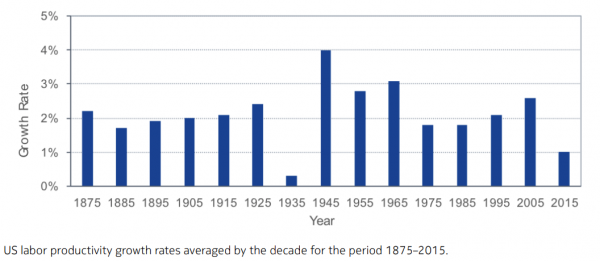Industry Thought Leadership
Technology for the “Greater Good”
January, 2018What good is technology?
I believe technology serves us best when it gives us more time to do things that are uniquely human. This includes activities that are enjoyable, creative, and productive.
For nations and societies, the “good” or benefit of technology is often expressed in economic terms, in measures such as workplace productivity and business growth.
As we move into the Fourth Industrial Revolution and the digital transformation of life as we know it, the potential benefits and risks of this new era are in ongoing discussion, in Davos and elsewhere. Will the Fourth Industrial Revolution deliver on its promises? Is it simply hype, or will it be a massive engine driving productivity gains, economic growth, and business success?
Lessons of the past
Nokia Bell Labs researchers have analyzed historical data from previous industrial revolutions to model and forecast the potential impact of the next one.
During both the First Industrial Revolution (which was fueled by iron and steam engines) and the Second (which was powered by electricity, steel, chemicals, and telecommunications), productivity boomed. Starting around 1870, these two revolutions sustained a Golden Century of progress. The 1940s and 1950s in particular, brought massive gains in the United States and elsewhere.
Then what happened? The Third Industrial Revolution arrived, ushering in the Information Age. Massive, world-changing innovations emerged in computing, the internet, mobile communications, and much more. Yet instead of revving up again, the productivity engine sputtered. In fact, since 1970, productivity growth has fallen to roughly one-third the rate of the previous 100 years.
If all the hard work, innovation, and investments in technology over the past half century have failed to pay off in productivity, what does this mean for the huge investments already taking place in the Fourth Industrial Revolution infrastructure?
A pessimist would say we should skip it and put our money elsewhere.
But I am an optimist. I absolutely believe that we are on the cusp of not just a technological revolution, but a productivity revolution. It will bring benefits for people everywhere, make our planet more sustainable, and provide new opportunities for businesses of all kinds.
Fortunately, Nokia Bell Labs’ research concurs with this view.
The causes of revolution
In analyzing what made the Golden Century of 1870 to 1970 possible, it becomes clear that four physical infrastructure technologies provided the underlying foundation for growth: energy, transportation, health and sanitation, and communication.

These fundamental technologies were important on their own, but two other factors were essential for accelerating growth. The first was when the diffusion – or adoption – of each technology was widespread enough to reach a tipping point. The second was a network effect: the technologies needed to work in tandem to drive growth. Only when all four technologies were widely diffused did fast growth happen.
Next, the research looked at today’s technologies. It found emerging digital equivalents that align with the four technology foundations of the Golden Century:
- Digital energy: combining smart power grids and smart meters into platforms that dynamically match energy generation and demand from both new and traditional sources.
- Digital transport: moving people and goods across oceans, skies, and land autonomously.
- Digital health: remotely enabling connected health care from anywhere.
- Digital communication: connecting billions of people and things, allowing them to interact in new ways.
A fifth foundational technology – digital production – was added to these. It will bring a paradigm shift, from centralized mass production to distributed, localized production, combining edge cloud computing and 3D printing to create goods in near real time.
Forecast for growth
By calculating when these digital technologies could reach their tipping points and by applying historical formulas, Nokia Bell Labs has projected a significant productivity jump, as much as 30% to 35% in the U.S., starting at some point between 2028 and 2033. This is a similar leap to the 1950s and could add approximately $2.8 trillion to the U.S. economy. Similar gains are anticipated in India, China, and other nations.

The widespread deployment of high-capacity, low-latency 5G networks is a major catalyst to the digital infrastructure of the future. This reality is not far off.Wide trials are taking place this year that could lead to full commercial 5G deployments in 2019. The U.S., China, Korea, and Japan are at the forefront of these efforts.
5G and cloud technologies will underpin and accelerate the digitalization of industries. In turn, this will create opportunities across nearly every segment of the economy, from health care to transport, energy, and beyond. Telecommunication companies that take the path to 5G now, and focus on software-defined networking and the cloud, have a massive opportunity to benefit from serving these industries during their transformations.
As in each of the previous industrial revolutions, such gains come with economic trade-offs and elicit new challenges. An obvious concern is the implication for skills development as the workforce transforms. Policy work is also urgently needed, as the UN Broadband Commission reported, both between governments and within countries. It must determine how the public sector can help identify and realize the benefits of digitalization, primarily by providing a framework for collaboration across different sectors of the economy.
Such work between governments, technology companies, and the emerging digital industries is an essential building block for realizing the massive potential of the Fourth Industrial Revolution.
This includes not just the economic potential, but also the personal and social benefits: making life better, preserving our planet’s resources, and giving people more time and freedom to connect with each other and the things they enjoy.
After all, these are the greater good that technology is meant to serve.

